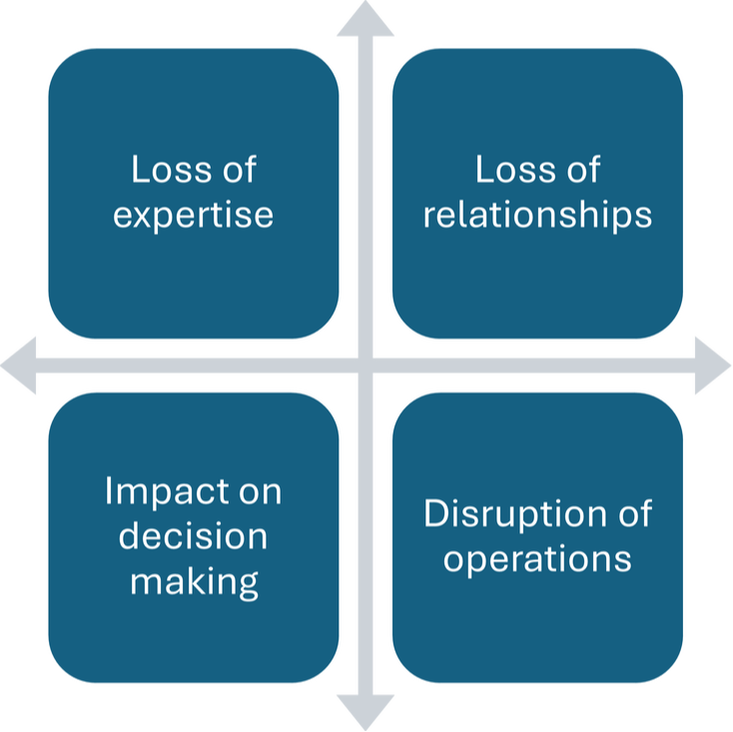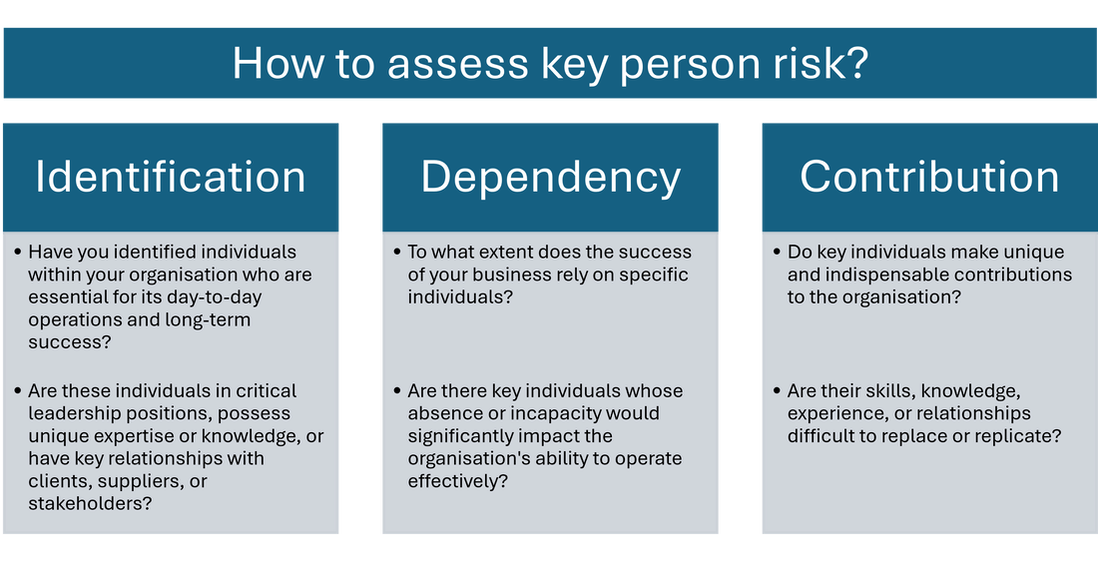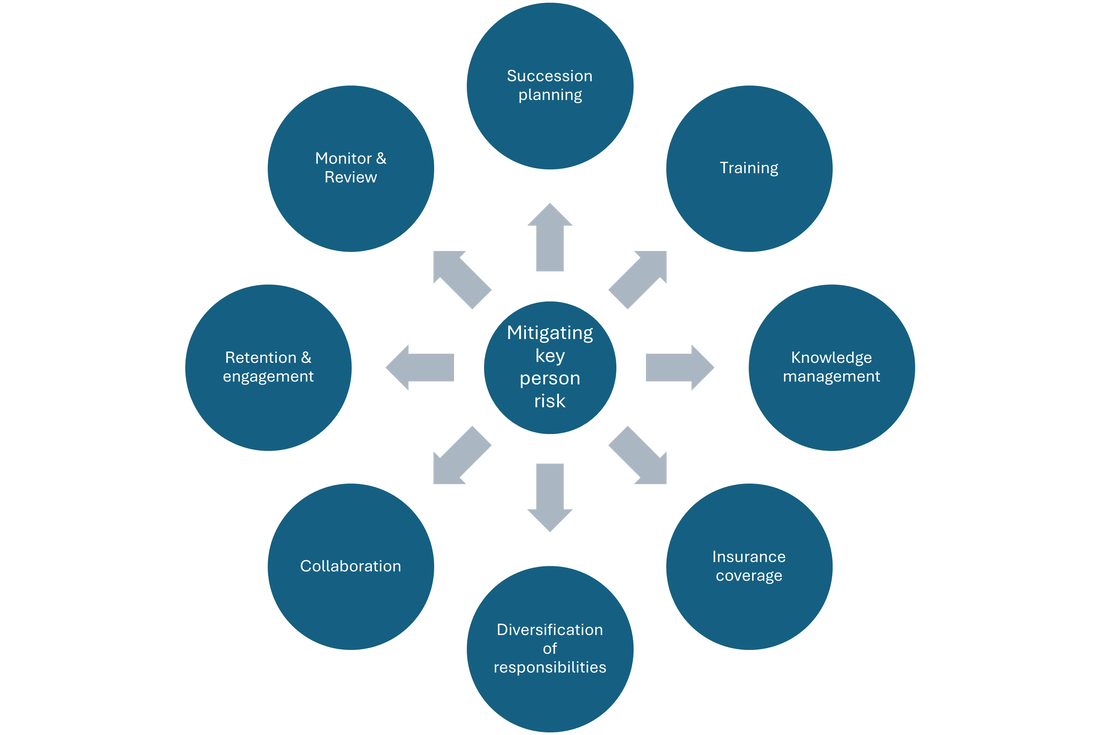|
Business success often hinges on the dedication, expertise, and leadership of key individuals within the organisation. This is especially true for small businesses. This reliance on specific employees introduces a significant vulnerability to your business known as key person risk. In this article we delve into the implications to small businesses, how to assess it, and practical strategies for mitigating this threat to business continuity and growth. What is key person risk?At the heart of every small business lies a handful of indispensable individuals whose contributions are instrumental in driving the business forward. Whether it's Jodie, the visionary founder, Shilpa the seasoned manager, David the top sales executive or Suzanne the office manager, these key persons play a pivotal role in shaping the organisation's success. However, their sudden departure, incapacitation, or loss can unleash a raft of challenges, ranging from operational disruptions and loss of customers to diminished morale and financial instability. Key person risk can manifest in various ways:  Loss of expertiseIf a key person possesses unique skills, knowledge, or experience essential for the operation of the business, their departure could lead to a loss of expertise, which may be difficult to replace. Loss of relationshipsKey individuals often have crucial relationships with customers, suppliers, or other stakeholders. The loss of such relationships due to the departure or incapacity of the key person can harm the business's revenue, reputation, or access to resources. Disruption of operationsA key person's absence may disrupt the day-to-day operations of the business, causing delays, decreased productivity, or strategic setbacks. Impact on decision makingKey individuals often play a significant role in decision-making processes within the organisation. Losing such individuals may lead to delays in decision-making or a shift in strategic direction, potentially affecting the business's competitiveness or performance. How to assess key person risk?Assessing key person risk requires an evaluation of various factors within the organisation. Step 1: Identification of key individuals
Step 2: Dependency on key individuals
Step 3: Assessment of contributions
Mitigating key person riskOrganisations must take a proactive approach to reduce their dependency on specific individuals. There are several strategies that can be used to mitigate key person risk. Succession planningDevelop formal succession plans to identify and groom potential successors for key roles within the organisation. Regularly review and update these plans to align with changing personnel dynamics and business objectives. Cross training initiativesImplement cross-training programs to equip multiple employees with the skills and knowledge necessary to perform critical tasks. This ensures a smooth transition of responsibilities in the event of key person absence or departure. Knowledge managementDocument critical knowledge, expertise, and processes to preserve institutional memory and facilitate knowledge transfer within the organisation. Foster a culture of knowledge sharing and collaboration to mitigate the impact of key person loss on day-to-day operations. Insurance coverageExplore key person insurance options to provide financial protection against the death or disability of senior key individuals. Select appropriate insurance policies tailored to the organisation's needs and risk tolerance. Diversification of responsibilitiesDistribute responsibilities and decision-making authority across multiple individuals or teams to reduce reliance on any single person. Encourage teamwork and collaboration to foster a cohesive work environment and collective problem-solving approach. Retention and engagementImplement strategies to retain key talent and foster a positive organisational culture that promotes employee engagement and loyalty. Monitor and reviewRegularly monitor the organisation’s key person risk and review the effectiveness of your mitigation strategies. Why key person risk mattersKey person risk poses a significant threat to the stability, growth, and long-term viability of small businesses. The sudden loss or incapacitation of key individuals like Jodie, Shilpa, David or Suzanne can disrupt operations, erode customer trust, and undermine employee morale. The financial implications of key person loss, including recruitment costs, training expenses, and potential revenue decline, can pose a substantial burden, especially those operating in competitive markets with narrow profit margins. Safeguarding against key person risk is paramount to ensuring business continuity and sustainability. By proactively assessing, understanding, and mitigating this critical threat, you can secure your organisation’s resilience, create a culture of preparedness, and position the business for long-term success amidst evolving challenges and opportunities. Need help?Are you looking for help with any of the following:
About Concept HR ServicesConcept HR Services helps small and medium businesses set up and maintain effective HR practices and processes to attract, manage, develop, and retain great employees.
Personalised HR solutions and day-to-day HR advice & support tailored to meet the specific needs of your business, your workplace and organisational culture. Comments are closed.
|
Archives
November 2025
Categories
All
|
|
People support that strengthens how your managers lead and how well your teams perform so you can stay focused on driving your business forward.
|



